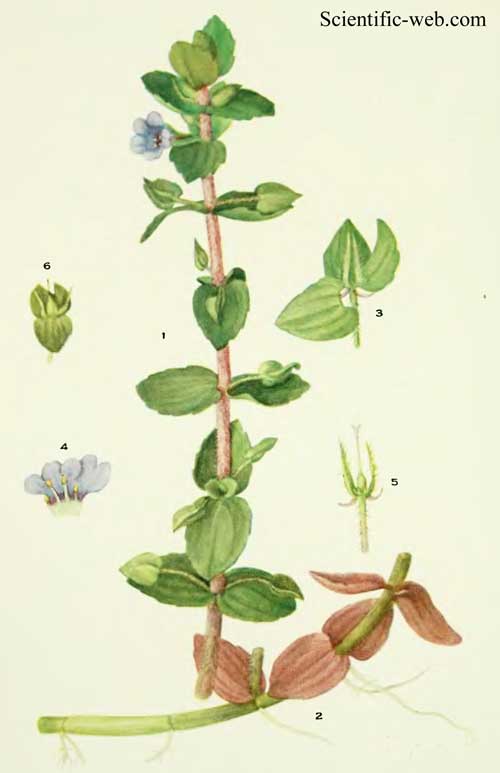
Bacopa caroliniana
Classification System: APG IV
Superregnum: Eukaryota
Regnum: Plantae
Cladus: Angiosperms
Cladus: Eudicots
Cladus: Core eudicots
Cladus: Asterids
Cladus: Lamiids
Ordo: Lamiales
Familia: Plantaginaceae
Tribus: Gratioleae
Genus: Bacopa
Species: Bacopa caroliniana
Name
Bacopa caroliniana (Walter) B.L.Rob., Rhodora 10: 66 (1908).
Synonyms
Basionym
Obolaria caroliniana Walter, Fl. Carol.: 166. Apr–Jun 1788.
Homotypic
Herpestis caroliniana (Walter) Britton, Sterns & Poggenb., Prelim. Cat.: 39 (1888).
Hydrotrida caroliniana (Walter) Small in N.L.Britton & A.Brown, Ill. Fl. N. U.S., ed. 2, 3: 193 (1913).
Moniera caroliniana (Walter) Kuntze, Revis. Gen. Pl. 2: 463 (1891).
Septilia caroliniana (Walter) Small, Fl. S.E. U.S.: 1064 (1903).
Heterotypic
Moniera amplexicaulis Michx., Fl. Bor.-Amer. 2: 22 (1803).
Bacopa amplexicaulis (Michx.) Wettst. in H.G.A.Engler & K.A.E.Prantl, Nat. Pflanzenfam. 4(3b): 77 (1891).
Herpestis amplexicaulis (Michx.) Pursh, Fl. Amer. Sept. 2: 418 (1813).
Macuillamia amplexicaulis (Michx.) Raf., Autik. Bot.: 44 (1840).
Moniera crenulata Small, Bull. Torrey Bot. Club 22: 46 (1895).
Hydrotrida crenulata (Small) Small, Fl. Miami: 165 (1913).
Septilia crenulata (Small) Small, Fl. S.E. U.S.: 1064 (1903).
Herpestis marginata Benth. in DC., Prod. 10: 398 (1846).
Bacopa marginata (Benth.) Pennell, Proc. Acad. Nat. Sci. Philad. 98: 98 (1946).
Distribution
Native distribution areas:
Continental: Africa
Regional: Western Indian Ocean
Réunion (introduced).
Continental: Australasia
Regional: Australia
New South Wales (introduced).
Continental: Northern America
Regional: South-Central U.S.A.
Texas.
Regional: Southeastern U.S.A.
Alabama, Florida, Georgia, Louisiana, Maryland, Mississippi, North Carolina, South Carolina, Tennessee, Virginia.
Continental: Southern America
Regional: Caribbean
Cuba.
Regional: Brazil
Brazil Northeast (Alagoas, Maranhão, Piauí), Brazil West-Central (Goiás, Mato Grosso, Mato Grosso do Sul) (introduced).
References: Brummitt, R.K. 2001. TDWG – World Geographical Scheme for Recording Plant Distributions, 2nd Edition
References
Primary references
Robinson, B.L. 1908. Further notes on the vascular plants of the northeastern United States. Rhodora 10(112): 64–68. BHL Reference page.
Additional references
Riehl, R. & Baensch, H.A. 2001. Atlas de l’aquarium. 14th edition, volume 1, p. 88–89. ISBN 3-88244-049-X. Reference page.
Links
Govaerts, R. et al. 2020. Bacopa caroliniana in Kew Science Plants of the World online. The Board of Trustees of the Royal Botanic Gardens, Kew. Published online. Accessed: 2020 Dec. 11. Reference page.
Tropicos.org 2020. Bacopa caroliniana. Missouri Botanical Garden. Published online. Accessed: 11 Dec. 2020.
Hassler, M. 2004–2020. World Plants. Synonymic Checklist and Distribution of the World Flora. Version 11.1; last update Dec. 8, 2020. - Bacopa. Last accessed 11 Dec. 2020.
USDA NRCS PLANTS Profile
International Plant Names Index. 2018. Bacopa caroliniana. Published online. Accessed: 30 Jun 2018.
USDA, ARS, Germplasm Resources Information Network. Bacopa caroliniana in the Germplasm Resources Information Network (GRIN), U.S. Department of Agriculture Agricultural Research Service. Accessed: 09-Oct-10..
Vernacular names
English: Blue Waterhyssop
français: Bacopa de Caroline
Bacopa caroliniana is a flowering plant species.
Common names
Giant red bacopa; lemon bacopa; water hyssop
Synonyms
Bacopa amplexicaulis; Obolaria caroliniana; Herpestes amplexicaulis; Herpestes caroliniana
Distribution
It commonly grows in marshy areas in the southern United States and in South Korea.
Description
Bacopa caroliniana is a perennial creeping herb. The leaves of this plant are succulent, smell of lemon if crushed, and are relatively thick. Leaves are oblanceolate and are arranged oppositely on the stem. The flowers are blue, with five petals. It grows to 50–100 cm (20–39 in).
It will grow above the water if given the chance with similar but waxy leaves and will even flower underwater occasionally, though the flowers soon rot. Emersed flowers do not produce seeds on their own, requiring cross pollination.
Cultivation
Its ability to grow in water makes it a popular aquarium plant. It can even grow in slightly brackish conditions. Propagation is through cuttings. It grows easily in the aquarium. The color of the leaves will vary, depending on the amount of light. The leaves will turn bronze or even almost red under high light levels.
In the wild it grows in bogs or semi-submersed conditions, adapting well if flooded and fully submerged. It can be grown in or by ponds in warmer locales (or in shallow dishes or as a house plant if kept sufficiently damp) and will grow all year round, but is frost tender (though it will normally grow back from the roots if damaged) and appreciates light shade.
In the aquarium it needs good lighting to grow strongly but will survive in even fairly low-light levels. Prefers a clean, nutriment rich environment.[1]
Bioluminescence
When gold nanoparticles were introduced into Bacopa caroliniana plants they caused the chlorophyll to produce reddish light.[2] While lit, the glowing plants' vegetation consumed more carbon from the atmosphere than normal (i.e. the luminescence causes the cells to undergo photosynthesis). The Taiwanese research team behind the discovery hopes to implement modified Bacopa caroliniana plants as environmentally friendly street lamps. Popular Science calls this a "triple threat," in that the "trees" could cut energy costs, reduce global warming, and keep streets safely lit at night.[3]
References
Gesting Berti, Nature and Aquarium, Bioplast
"Nanoparticles make leaves glow".
"Trees Infused With Glowing Nanoparticles Could Replace Streetlights".
Retrieved from "http://en.wikipedia.org/"
All text is available under the terms of the GNU Free Documentation License

